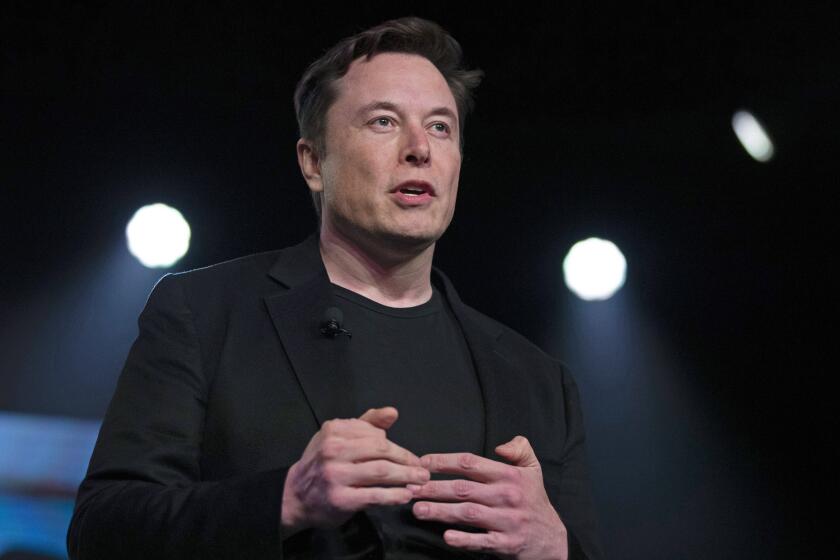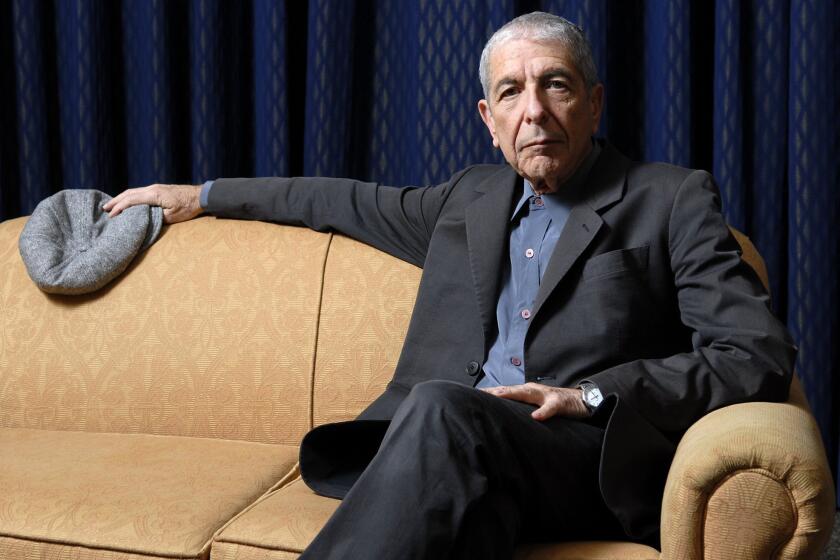Disney’s massive streaming gamble has arrived. It may change the TV industry forever
- Share via
Television may never be the same.
After two years of planning, the Walt Disney Co. on Tuesday finally launches Disney+, the much anticipated streaming service that marks one of the Burbank company’s biggest gambles to date.
Disney has spent more than $3 billion on technology and content in an ambitious bid to take on Netflix at its own game. The $6.99-a-month service boasts a deep library, including movies and TV shows from Pixar Animation, “Star Wars,” Marvel Studios and classic Disney fare.
“Disney is approaching Disney+ with guns a-blazing,” said Patrice Cucinello, an analyst with Fitch Ratings in New York. “It’s an aggressive effort: They want to be one of the top choices for consumers seeking entertainment.”
The new product represents a shift in Disney’s business strategy and potentially, another blow to the traditional pay-TV bundle that has been so important to its business. Cord-cutting is on the rise, taking a big bite out of revenue to Disney’s cable sports empire, ESPN, and other channels.
Disney blames user login issues related to its new streaming service launch on higher than expected consumer demand.
The new streaming option could entice more people to cancel their pay-TV subscriptions, further jeopardizing the health of an important profit center — the fees that cable and satellite TV operators pay for programming. Nearly a quarter of U.S. households are expected to drop traditional TV subscriptions by 2022, according to research firm eMarketer. The number of people in the U.S. who stream video through subscription services is expected to reach 205.6 million in 2023, up from 182.5 million this year, according to eMarketer.
Disney faces formidable competition from rivals including Netflix, which has a big head start with 158 million subscribers and is spending about $15 billion on content this year.
But Disney Chairman and Chief Executive Bob Iger fervently believes that the companies that forge strong relationships with consumers will be the ones that survive the digital migration. His legacy will be judged, in large part, on the success of Disney+.
“With the launch of Disney+, we’re making a huge statement about the future of media and entertainment and our continued ability to thrive in this new era,” Iger told analysts last week.
The 96-year-old company’s push into direct-to-consumer entertainment was a primary driver of its biggest acquisition ever, the $71.3-billion purchase of much of Rupert Murdoch’s 21st Century Fox. That deal closed in March after a bidding war with rival Comcast Corp., resulting in months of haggling that ultimately drove up the price that Disney had to pay for the Fox assets, including control of streaming service Hulu, the National Geographic channels and ownership of “The Simpsons.”
What to stream — and what to skip — when Disney+ launches on Tuesday.
Disney+ will also be a key test for one of Iger’s chief lieutenants, Kevin Mayer. The hard-charging 57-year-old executive, who is seen as a potential successor to Iger, has managed the development and rollout of Disney+.
Mayer was named chairman of Disney’s direct-to-consumer and international division in March 2018 after years of serving as a business development and corporate strategy executive at the company. He led key acquisitions including Marvel Entertainment, Lucasfilm and BamTech, the previously little-known firm that provided the technological backbone of Disney’s streaming efforts.
Mayer has been anxiously awaiting Tuesday’s launch and sweating over details, big and small. He wanted to make sure the technology could handle tens of thousands of simultaneous online orders and even tweaked the shape of the plus sign in the Disney+ logo that greets users on screens.
“We’ve worked extremely hard to create a service that’s second to none,” Mayer said last week during a preview at the company’s headquarters in Burbank.
Everything we know so far about Disney+, including the cost of a subscription and what films and TV shows will be available at launch on Nov. 12.
Anticipation in the Team Disney building was palpable. Agnes Chu, senior vice president of content for Disney+, said the group even eyed an actual countdown clock in its work-space kitchen. The digital clock, with red letters, marked the days, hours, minutes — even seconds — to launch.
Thousands of Disney employees have been perfecting the app’s design and navigation, unfurling marketing initiatives and creating content for the service. Since September, the company has been testing the app with consumers in the Netherlands, which provided an early glimpse of the audience makeup and the popularity of shows. (“Marvel’s Agents of S.H.I.E.L.D.,” the Disney Channel’s “The Suite Life of Zack and Cody” and for toddlers, “Mickey’s Clubhouse,” were the most-viewed programs).
Iger, in brief remarks, sounded an optimistic, if slightly cautious, note.
“To use the word ‘excited’ would probably be an understatement,” he said. “I feel great about what we’ve done.”
To market Disney+ to potential subscribers, Disney has waged, in the words of the app’s content and marketing president, Ricky Strauss, “the biggest synergy campaign ever in the history of the Walt Disney Co.” Its promotional push spans theme parks, cruise lines, city buses, Disney retail stores and on its various TV networks, including ABC, ESPN, Freeform and FX.
Last month, the ABC show “Dancing With the Stars,” dedicated an episode to Disney stories and characters. And last week, Iger even appeared on the radio show “On Air With Ryan Seacrest,” touting Disney+ as “the answer to today’s consumer’s dreams.”
The company is hoping to lure subscribers with its first live-action “Star Wars” series, “The Mandalorian”; a new “High School Musical” show and multiple Marvel series from the superhero studio’s guiding light, Kevin Feige.
“The Mandalorian” follows in the “Star Wars” franchise’s grand tradition: The premiere is action-packed and predictable in equal measure.
The thinking was to make the app the streaming home for all Disney, Pixar, Marvel, Star Wars and National Geographic content. Virtually all of Disney’s classic vault will be available on the service, along with Fox movies such as “Avatar” and 30 seasons of “The Simpsons.” In the first year, the service will have 25 original series, more than 10 original movies and specials, 7,500 TV episodes from the Disney-owned catalog and more than 500 movies.
The company recently screened scenes from “The Mandalorian,” showing off the series’ impressive visuals and sci-fi action. The show, helmed by Jon Favreau, cost at least $100 million to produce.
Disney+ will cost $6.99 a month, or $70 for a full year, which is substantially less than comparable offerings from Netflix ($13 a month for its most common plan) and AT&T’s forthcoming HBO Max ($15 a month, when it goes live in May).
“Disney was very smart in building a platform with a price point that wasn’t too high,” said media analyst Michael Nathanson. “The price of Disney+ will put more pressure on Netflix not to jack up its price.”
Analysts have speculated that Disney will sign up 5 million to 10 million customers for Disney+ this year. Company executives declined to share their forecasts beyond saying they expect 60 million to 90 million customers globally by 2024.
In addition to the U.S. and Canada, the service gets a wider rollout in the Netherlands on Tuesday. This month, it will also be introduced in Australia and New Zealand before debuting next spring in parts of western Europe.
Analysts have been largely enthusiastic about Disney+’s prospects, citing the strength of its content. The company has said that Disney+ should be profitable within five years.
“They have a very solid financial profile to embark on this evolution,” Cucinello said. “They are trading some profitability in the short term by investing heavily in content and technology to support the platform and add scale through subscriber growth.”
But Disney has struggled in the past with tech-related ventures. Its pricey acquisition of YouTube network Maker Studios fizzled, as did the online game network Playdom and Club Penguin. In 2001, Disney shut down its Go.com portal, acknowledging that the site’s services and content were subpar.
Disney has taken pains to reduce the chance of anything like that happening with Disney+. “We’ve been approaching this pretty critically, because we want this to be right,” Iger said.
Another challenge is a perception that Disney content is geared for little kids and their parents. While the service will not contain R-rated content or programming designated for mature audiences, executives said the offerings should appeal to a so-called four-quadrant audience — male, female, young and old.
“It’s incumbent on us to market it the right way, to emphasize that it’s not just for kids,” Mayer said.
Because much of the audience will be families, Disney wanted to simplify the user experience. In addition to buttons dedicated to its five key brands, Disney+ organized its content in categories including nostalgic ’90s movies, classics from the vault and musicals. For fans of “Beauty and the Beast,” Disney+ also offers the 2018 documentary about songwriter Howard Ashman and the new Kristen Bell show “Encore,” which reunites cast members of real life high-school musicals.
Some analysts and industry insiders worry that Disney+ and competing services could accelerate cord-cutting. Disney, for example, is offering a bundle of streaming services — Disney+, ESPN+ and Hulu — to consumers for as little as $12.99 a month.
Nathanson, the analyst, said he doubts that Disney+ “will be the fatal blow to the pay TV bundle,” noting that live sports remains a key draw for pay-TV customers.
Disney talks up its upcoming streaming service Disney+ for fans in Anaheim, with previews of shows including “The Mandalorian.”
The greater risk in the short term, he said, could be to movie ticket sales and home video rentals.
The startup costs and losses from Hulu have weighed on Disney’s earnings. Hulu will become the landing pad for ABC and FX shows, beginning next spring.
Disney’s direct-to-consumer segment, which includes Disney+, ESPN+ and Hulu, lost $1.81 billion in fiscal 2019, causing a 17% drop in profit to $10.44 billion in fiscal 2019, Disney said Thursday.
When an analyst asked him last week if he placed a bet on subscriber counts for Disney+, Iger quipped:
“If there is an office pool,” he said, “I’m not participating in it and I don’t intend to.”
More to Read
Inside the business of entertainment
The Wide Shot brings you news, analysis and insights on everything from streaming wars to production — and what it all means for the future.
You may occasionally receive promotional content from the Los Angeles Times.












